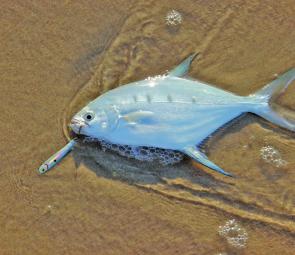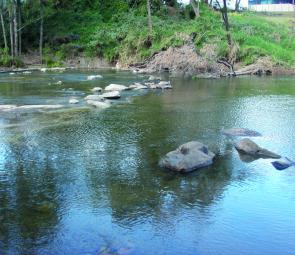I wouldn’t be at all sorry if October lasted three or four months – then there might be enough time to get to do all the good stuff that seems to happen around now.
It’s peak time in the upper rivers, when the bass are hungry enough to eat anything and are still finishing up their travels back to their sweetwater homes.
This season they’ve been very willing combatants; feisty, aggressive and in excellent condition.
Part of the reason for their prime condition is the amount of bait in the Richmond River and its tributaries, with abundant schools of the freshwater herring that bass heavily rely on for forage as both species head upstream.
And despite the severe lack of rain over the past couple of months, the deluges from February to May have ensured plenty of groundwater and still excellent levels of flow in the rivers.
That means the water quality has been very good and there have been few obstructions to travelling fish and plenty of deep water to hide in when the sun is overhead.
From day one of the river season, the bass have been belting herring look-alikes such as surface stickbaits and shallow-swimming shads in paler, reflective colours.
But, as the air warms even further and insect hatches become abundant, we should see the fish switching their attention to more terrestrial-type paddlers, like the Jitterbug/Crazy Crawler and other creature-type lures.
The bait scenario is also dominating fish movements in the lower estuaries, where flathead, whiting and jewfish have been the big movers.
Herring, mullet and school prawns rank high on the menu for flatties and jewfish, while prawns and worms are the favourites of the whiting.
Some big prawns are already schooling up in the middle to lower reaches and baitfish numbers are also reasonably good.
School jew numbers are quite fair after a good recruitment in the past 18 months so Matt Taylor and the University of NSW should get some good samples from fishos participating in the Mulloway Classic next month. It’s a data-gathering project to assess information on stocked mulloway, for more information check last month’s NSWFM tournament news, email --e-mail address hidden-- or call Elke Venstra on 02 9385 2118.
If the current dry spell continues, and there’s very little reason to believe it will rain much before Lismore Show time around the middle of November, there could be jewies, bream and school flathead as far as the tide carries salt water.
Tidal limits in the Richmond catchment are generally Yellow Crossing on the Bungawalbyn arm, Grays Falls just east of Casino and Boatharbour on the Wilsons arm.
If the rain stays away, water down near the Richmond entrance at Ballina will just become clearer and clearer, making for some difficult fishing in broad daylight. Better catches will be during the early mornings and evenings, especially when it comes to flathead and whiting.
The flatties often come down to spawn in October so there could be some big females lying up in the shallows early and late in the day and hanging in the depths along the rock walls when it’s bright.
For the future of Richmond River flatties, the big mummas need to be returned to the water alive. The Queensland slot limit of 40cm to 75cm should be universally adopted so the most successful breeders are allowed to remain in the system, safe from the selfish and dubious exploits of ego-trippers and meat merchants.
There should be some decent catches of school flathead eminently suitable for a feed. Try the edges of the sandbars in North Creek, around the Porpoise Wall, at Burns Point and Pimlico.
The sandbars and deeper running flats should produce increasingly good whiting this month, too. Live bloodworms are essential to catch the most and the best Richmond whiting but you’ll get a few on beach worms and yabbies.
Of course, there’ll be whole flotillas of fishos out to chase them with poppers and vibrating blades and there could be some sob-stories of lost lures if we get a half-decent run of GTs working the same waters.
There’ll be more whiting out on the beaches, along with plenty of dart, but if you don’t bait up with beach worms you’ll be missing out on the best of the beach action this month.
That’s unless you scale your lures right down and just concentrate on the dart. I’ve been casting bright metal slugs around 12g to 18g and had a ball catching some extremely respectable dart that at times have nudged 700g.
They seem to like a fairly agitated retrieve with plenty of rod action and inevitably seem to hit the lure when it’s then allowed to drop to the sand for a few seconds.
When they’re only 20cm long and stealing your worm baits, dart are indeed pests but on ultra-light gear, the ones big enough to hit a lure go hard and even turn out pretty sweetly on the plate.
Out on the briny, there should still be snapper spawning this month although most of the action is from 40m and deeper. This is usually also a good month for teraglin, which can sometimes save the day when the snapper refuse to play.
Out wide there are normally hundreds of snapper traps this month, with the current starting to run strongly enough some days to drag under their bubble floats.
The water should also become warmer this month as that current pushes closer to shore.
And as the land heats up we can expect plenty of north-easters to come charging in from mid-morning, so it’s wise to get back to shore before its full effects take hold.
Reads: 1689
The bass this river season have been active, hungry and in great condition.

After a dismal tailor season, quality surf dart caught on scaled-down tackle offer some solace.

A couple of months of dry weather haven’t hurt river flows at this stage. Groundwater levels are still pretty good after such a wet autumn. This is where the Manyweathers Weir once stood at Casino.




